Coat of arms of Lithuania
The coat of arms of Lithuania, consisting of an armour-clad knight on horseback holding a sword and shield, is also known as Vytis (pronounced ['vîːtɪs][1].
| Coat of arms of Lithuania Lietuvos herbas Vytis | |
|---|---|
 | |
| Versions | |
 Presidential version | |
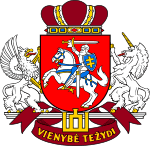 Parliamentary version | |
| Armiger | Republic of Lithuania |
| Adopted | First documented in 1366. Current version official since 1991. |
| Blazon | Gules, an armoured knight armed cap-à-pie mounted on a horse salient holding in his dexter hand a sword Argent above his head. A shield Azure hangs on the sinister shoulder charged with a double cross (Cross of Lorraine) Or. The horse saddles, straps, and belts Azure. The hilt of the sword and the fastening of the sheath, the stirrups, the curb bits of the bridle, the horseshoes, as well as the decoration of the harness, all Or. |
| Earlier version(s) | see below |
Article 15 of the Constitution of Lithuania, approved by national referendum in 1992, stipulates, "The Coat of Arms of the State shall be a white Vytis on a red field". The heraldic shield features the field gules (red) with an armoured knight on a horse salient argent (silver). The knight is holding in his dexter hand a sword argent above his head. A shield azure hangs on the sinister shoulder of the knight with a double cross/two-barred cross or (gold) on it. The horse saddle, straps, and belts are azure. The hilt of the sword and the fastening of the sheath, the stirrups, the curb bits of the bridle, the horseshoes, as well as the decoration of the harness, are or (gold).
The blazon is the following:
Gules, a knight armed cap-à-pie mounted on a horse salient argent, brandishing a sword proper and maintaining a shield azure charged with a cross of Lorraine Or.
History
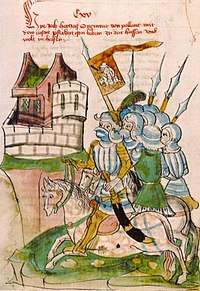


Origin
The knight on horseback without a specific name was mentioned in the Tobolsk Chronicle as a symbol of Narimantas. The charging knight is depicted on the seal of Grand Duke of Lithuania Algirdas, dated 1366. The earliest coins featuring the knight come from the last quarter of the 14th century; the other side of these coins depicts the Columns of Gediminas. The emblem was handed down through the generations, from Algirdas to his son, Grand Duke Jogaila, then to Jogaila's cousin Grand Duke Vytautas and others. In the 14th century, the knight was featured on a heraldic shield, first on Jogaila's seal in 1386 or 1387, and also on the seal of Vytautas in 1401. At the Battle of Grunwald in 1410, the major victory of the united Polish–Lithuanian army against the Teutonic Order, thirty Lithuanian regiments out of the total forty were flying the "charging knight" banner.
At first, the charging knight was depicted riding to left or right, and holding a lance instead of the sword. Two seals of Lengvenis of 1385 and of 1388 exhibit this change.[2] The lance was more often exhibited on the seals of Skirgaila and Kaributas. By the first half of the 15th century, the rider is always shown riding to the left (as seen by the viewer) with a sword in his raised hand and a shield in the left hand (if he rode to the right, the shield would be concealed by the rider). During the 15th century, the colors of the seal became uniform: a white (silver) charging knight holding a sword and a shield on a red field.
Use as a state symbol
By the 15th century, the heraldic knight became representative of the Grand Duchy of Lithuania and of its central part, the Duchy of Vilnius. Its name Pogonia is first recorded in the Statutes of Lithuania of 1588.[3]
In the 16th century, the knight's shield was depicted as blue with a gold double cross, constructed in such a way that all six ends are equal in length. The double cross was attributed to Jogaila, who was said to have adopted it after his baptism as Ladislaus and marriage with Hungarian princess and King of Poland Hedvig Angevin in 1386. It is derived from the Hungarian cross, the assumed coat of arms of Saint Ladislaus, King of Hungary, which is in turn a derivative of the Patriarchal cross.
The Renaissance introduced minor stylistic changes and variations: long feathers waving from the tip of the knight's helm, a long saddle-cloth, the horse tail turned upwards and shaped as nosegay. With these changes the coat of arms remained the State symbol of the Grand Duchy of Lithuania until 1795, when Lithuania was annexed to the Russian Empire. Traditional Lithuania's coat of arms was abolished. However, in 1845 tsar Nicholas I confirmed a coat of arms for the Vilna Governorate that closely resembled the historical one. A notable later change was the replacement of the double cross with the red Byzantine cross on the knight's shield.
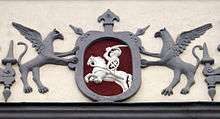
At first, the charging knight was interpreted as the ruler of the country. As time passed, he became a knight who is chasing intruders out of his native country. Such an interpretation was especially popular in the 19th century, and the first half of the 20th century, when Lithuania was part of the Russian Empire and sought its independence.
.jpg)
Following the partition of the Polish-Lithuanian Commonwealth, most of the Grand Duchy of Lithuania was absorbed by the Russian Empire and the Vytis was incorporated into the imperial state emblem. The Vytis was the coat of arms of the Vilna Governorate following the incorporation of Vilnius and surrounding lands into the Russian Empire. Statues of the Vytis placed on white columns greeted visitors at the entrances to Vilnius from 1818 until 1840, when the statues were replaced with two-headed eagles – the state symbol of the Russian Empire.
Uprisings to restore the Polish-Lithuanian Commonwealth like the 1830-31 November Uprising and 1863-64 January Uprising saw the Vytis used as a symbol of rebellion against the Russian Empire.
_(1845).png)

When Lithuania restored its independence in 1918–1920, several artists produced updated versions of the coat of arms. Almost all included a scabbard, which is not found in its earliest historic versions. A romanticized version by Antanas Žmuidzinavičius became the most popular. The horse appeared to be flying through the air (courant). The gear was very ornate. For example, the saddle blanket was very long and divided into three parts. There was no uniform or official version of the coat of arms. To address popular complaints, in 1929 a special commission was set up to analyze the best 16th century specimens of Vytis to design an official state emblem. Mstislav Dobuzhinsky was the chief artist. The commission worked for 5 years, but its version was never officially confirmed. Meanwhile, a design by Juozas Zikaras was introduced for official use on Lithuanian coins.
The Vytis was the state emblem of the Republic of Lithuania until 1940, when the Republic was annexed by the Soviet Union and national symbols were suppressed. With the dissolution of the Soviet Union, the Vytis, together with the Columns of Gediminas and the national flag, became symbols of the independence movement in Lithuania. In 1988, Lithuania's Soviet authorities legalised the public display of the Vytis.
On March 11, 1990 Lithuania declared its independence and restored all of its pre-war national symbols, including its historic coat of arms. On March 20, 1990 the Supreme Council of Lithuania approved the description of the State's coat of arms and determined the principal regulations for its use. The design was based on Juozas Zikaras' version. This was to demonstrate that Lithuania was resuming the traditions of the state that existed between 1918–1940. On September 4, 1991, a new design by Arvydas Každailis was approved based on recommendations of a special heraldic committee. It abandoned romantic interwar interpretations, harkening back to the times of the Grand Duchy of Lithuania. It re-established the original colors, but placed the horse and rider in an ostensibly more "defensive" posture, airs above the ground rather than leaping forward and sword simply elevated rather than poised to strike. However, Lithuanian coins featured Zikaras' design until they were replaced by the euro in 2015.
.jpg)
.svg.png)
In 2004, Lithuania's Seimas confirmed a new variant of the Vytis on the historical flag of Lithuania. It is depicted on a rectangular red fabric, recalling the old battle flags of the Grand Duchy of Lithuania. The flag does not replace the yellow-green-red tri-color national flag of Lithuania. It is used on special occasions, anniversaries, and buildings of historic significance.
It is currently proposed that a larger version of the coat of arms be adopted. It would feature a line from "Tautiška giesmė", the national anthem of Lithuania, "Vienybė težydi" ("May unity blossom"). The Seimas already uses a larger version of the coat of arms with this phrase as its motto, along with two supporters: the dexter one a griffin argent beaked and membered or, langued gules, and the sinister one a unicorn argent, armed and unguled or, langued gules, and the ducal hat on top of the shield. The President of Lithuania uses the shield and supporters only.
Lithuania joined the Eurozone by adopting the euro on 1 January 2015.[4] The designs of Lithuanian euro coins share a similar national side for all denominations, featuring the Vytis and the name of the country, "Lietuva". The design was announced on 11 November 2004 following a public opinion poll conducted by the Bank of Lithuania. The horse is again leaping forward, as in more traditional versions.
Interpretations
Jonas Trinkūnas, the leader of a neo-pagan movement Romuva, believes that in the Lithuanian mythology Vytis represents Perkūnas, a god of thunder.[5] It is believed that the Vytis may represent Perkūnas as supreme god or Kovas who was also a war god and has been depicted as a horseman since ancient times. Gintaras Beresnevičius also points out that a white horse had a sacral meaning to Balts. These interpretations coincide with one of the interpretations of the German coat of arms, that suggests an adler being the bird of Odin, a god of war, which is commonly depicted as a horserider.
Origins of the word Vytis
.jpg)
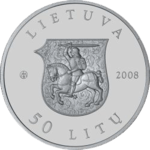
It is unknown for certain what Lithuania's coat or arms was initially called; Edmundas Rimša claims that the Ruthenian word Pogonia was used for it for the first time in the 16th century.[6][7] The earliest known Lithuanian name for the coat of arms is a 17th-century translation of Pogonia by Konstantinas Sirvydas as Waikimas ("Vaikymas" in the modern Lithuanian orthography), which was used until the 19th century together with Pagaunia.[8]
The origins of the Lithuanian proper noun Vytis are not clear either. At the dawn of the Lithuanian National Revival, Simonas Daukantas employed the term wytis, referring to the crest in this way for the first time in his historical piece Budą Senowęs Lietuwiû kalneniu ir Żemaitiû, published in 1846. The etymology of this particular name is not universally accepted; it is either a direct translation of the Polish Pogoń, a common noun constructed from the Lithuanian verb vyti ("to chase"), or, less likely, a derivative from the East Slavic title of the knight, vytiaz'. The first presumption, raised by the linguist Pranas Skardžius in 1937, is challenged by some, since Pogoń does not actually mean "chasing (knight)". In support of the second proposal, the Lithuanian language has words with the stem -vyt in such personal names as Vytenis; furthermore, vytis has a structure common to words constructed from verbs.[9]
In 1884, Mikalojus Akelaitis coined the Lithuanian name Vytis for the coat of arms in the newspaper Auszra.[10] This name came to popular use and was eventually legitimized and became official in the independent Republic of Lithuania.
Old Prussian word vi̇tingas had a meaning of a nobleman, knight.
In the Russophone world and the East Slavic culture there is a similar word Vityaz which means a brave knight or a bold hero. According to the Brockhaus and Efron Encyclopedic Dictionary, that word is derived from the Old Germanic Witing.[11] In western South Slavic languages (Slovenian, Croatian/Serbian/Montenegrin and Macedonian) vitez denotes the lowest feudal rank, a knight.
Similar coats of arms
The Pahonia coat of arms of Belarus, which was used in 1918 and again from 1991 to 1995, is very similar to the Vytis, with slight differences. In particular, the patriarchal cross with arms of uneven length is displayed on the shield, the saddle blanket is of the Renaissance style, and Azure is absent from it altogether.
Several Gediminid Lithuanian, Polish and Russian noble families adopted the earlier versions of the coat of arms with some modifications, namely Czartoryski, Trubetzkoy and Galitzine.
Recently adopted coats of arms of Vilnius and Panevėžys counties use different color schemes and add additional details to the basic image of the knight. Several towns in Lithuania use motifs similar to the Vytis. For example, the coat of arms of Liudvinavas is parted per pale. One half depicts the Vytis and the other, Lady Justice.
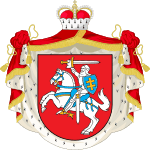 Vytis as it was used in the Grand Duchy of Lithuania
Vytis as it was used in the Grand Duchy of Lithuania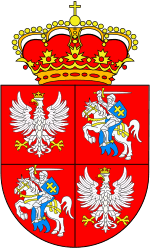
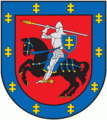 Vilnius County coat of arms
Vilnius County coat of arms.png) Vytis (Antanas Žmuidzinavičius' design; popular in interwar independent Lithuania)
Vytis (Antanas Žmuidzinavičius' design; popular in interwar independent Lithuania) Vilna Governorate coat of arms
Vilna Governorate coat of arms.svg.png) Pahonia, the coat of arms of Belarus 1918 and 1991–1995
Pahonia, the coat of arms of Belarus 1918 and 1991–1995.jpg) Third statute of Lithuania featuring Vytis
Third statute of Lithuania featuring Vytis An unknown version of the First Lithuanian Republic coat-of-arms, probably its greater coat of arms
An unknown version of the First Lithuanian Republic coat-of-arms, probably its greater coat of arms.jpg) The first page of the Latin copy of Laurentius (1531) of the First Statute of Lithuania. Vytis is drawn on a damasked shield.
The first page of the Latin copy of Laurentius (1531) of the First Statute of Lithuania. Vytis is drawn on a damasked shield.
See also
| Wikimedia Commons has media related to National coats of arms of Lithuania. |
- Pogoń Litewska coat of arms
- Emblem of the Lithuanian Soviet Socialist Republic
- Flag of Lithuania
- Pahonia
References
- "Lietuvių kalbos žodynas". www.lkz.lt. Retrieved 2020-05-18.
- (in Lithuanian) The peculiarities of the earliest Lithuanian coins
- Статут Вялiкага княства Лiтоўскага 1588. Тэксты. Даведнiк. Каментарыi. (in Old Belarusian). Mensk. 1989 [1588]. Archived from the original on 2007-11-19. Retrieved 2008-03-21.
Тежъ мы, г[о]с[по]д[а]ръ, даемъ подъ геръбомъ того паньства нашого, великого князства литовъского, "Погонею" печать до кожъдого повету
Transliteration: Teź' my, g[o]sp[o]d[a]r', daem' pod' ger'bom' togo pan'stva nasogo, velikogo kniazstva litov'skogo, "Pogoneju" pečat' do koź'dogo povetu
Translation: We, the King, bring the seal with "Pogonia", the coat of arms of our state of Grand Duchy of Lithuania, for every powiat - http://www.consilium.europa.eu/en/splash/?requested=%2fhomepage%2fhighlights%2flithuania-adopts-the-euro%2f%3flang%3den
- Lithuanian National Coat of Arms
- Rimša, Edmundas (2004). Heraldika. Iš praeities į dabartį (in Lithuanian). Vilnius: Versus aureus. pp. 61–63. ISBN 9955-601-07-8.
Neturėjo jis ir vyčio vardo, kaip neretai rašoma mūsų literatūroje.
- Rimša, Edmundas (2005), p.121
- Lietuviškoje XVIIIa. pabaigos – XIXa. literatūroje valstybės herbas, galima sakyti, vadintas tik Vaikymu, kuris neabejotinai yra lenkiškojo Pogonia atitikmuo
- Jonas Palionis. Kieno sukurtas Lietuvos herbas (Vytis). Literatūra ir menas, 2002
- Šiandien visiem gerai žinomą vyčio terminą XIXa. viduryje, tiesa, ne herbui, bet raiteliui (riteriui) apibūdinti pirmasis panaudojo Simonas Daukantas, o herbui – 1884m. „Aušroje“ jį pabandė pritaikyti Mikalojus Akelaitis
- Definition of Vityaz by Brockhaus and Efron Encyclopedic Dictionary
- The Coat of Arms of Lithuania, Seimas
- Gimtoji istorija, Nuo 7 iki 12 klasės (Lietuvos istorijos vadovėlis), CD, 2002, ISBN 9986-9216-7-8
- Simas Sužiedėlis and Antanas Vasaitis (ed.), Encyclopedia Lithuanica, Boston: 1978, Vol. VI, pages 223-225.
- Gintaras Beresnevičius, Lietuvių religija ir mitologija, Tyto alba, Vilnius: 2004. Pages 66–69. ISBN 9986-16-389-7